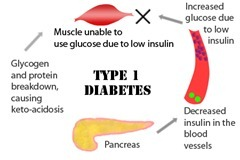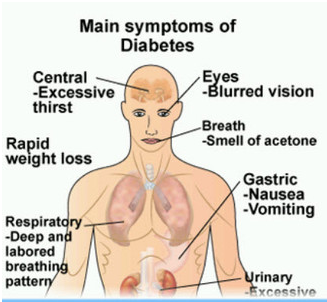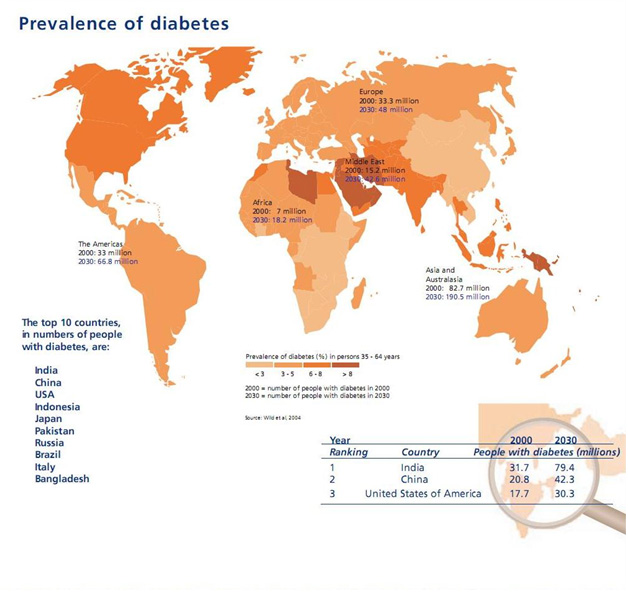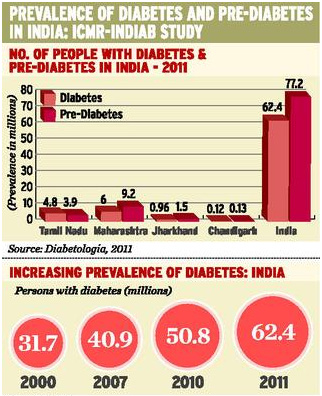Diabetes
India has more diabetics than any other country in the world, according to the International Diabetes Foundation. The disease affects more than 50 million Indians - 7.1% of the nation's adults - and kills about 1 million Indians a year.
Diabetes is a disease in which your blood glucose, or sugar, levels are higher than the normal levels. This happens because either the pancreas does not produce enough insulin, or because cells do not respond to the insulin that is produced. Patients with high blood sugar will typically experience polyuria (frequent urination). They will also become increasingly thirsty (polydipsia) and hungry (polyphagia). Over time, having too much glucose in your blood can cause serious problems such as damage to your eyes, kidneys, and nerves. Diabetes can also cause heart disease, stroke and even the need to remove a limb.

Type 1 diabetes
Type 1 diabetes occurs when the body's own immune system destroys the insulin-producing cells of the pancreas (called beta cells).
Normally, the body's immune system fights off foreign invaders like viruses or bacteria. But for unknown reasons, in people with type 1 diabetes, the immune system attacks various cells in the body. This results in a complete deficiency of the insulin hormone.
Understanding Insulin and Type 1 Diabetes
Normally the hormone insulin is secreted by the pancreas in low amounts. When you eat a meal, sugar (glucose) from food stimulates the pancreas to release insulin. The amount that is released is proportional to the amount that is required by the size of that particular meal.
Insulin's main role is to help move certain nutrients -- especially sugar -- into the cells of the body's tissues. Cells use sugars and other nutrients from meals as a source of energy to function.
The amount of sugar in the blood decreases once it enters the cells. Normally that signals the beta cells in the pancreas to lower the amount of insulin secreted so that you don't develop low blood sugar levels. But the destruction of the beta cells that occurs with type 1 diabetes throws the entire process into disarray.
In people with type 1 diabetes, sugar isn't moved into the cells because insulin is not available. When sugar builds up in the blood instead of going into cells, the body's cells starve for nutrients and other systems in the body must provide energy for many important bodily functions. As a result, high blood sugar develops and can cause:

- Dehydration The build up of sugar in the blood can cause an increase in urination (to try to clear the sugar from the body). When the kidneys lose the glucose through the urine, a large amount of water is also lost, causing dehydration.
- Weight loss The loss of sugar in the urine means a loss of calories which provide energy and therefore many people with high sugars lose weight. (Dehydration also contributes to weight loss
- Diabetic ketoacidosis Without insulin and because the cells are starved of energy, the body breaks down fat cells. Products of this fat breakdown include acidic chemicals called ketones that can be used for energy. Levels of these ketones begin to build up in the blood, causing an increased acidity. Te liver continues to release the sugar it stores to help out. Since the body cannot use these sugars without insulin, more sugars piles into the blood stream. The combination of high excess sugars, dehydration, and acid build up is known as "ketoacidosis" and can be life-threatening if not treated immediately.
- Damage to the body. Over time, the high sugar levels in the blood may damage the nerves and small blood vessels of the eyes, kidneys, and heart and predispose a person to atherosclerosis (hardening) of the large arteries that can cause heart attack and stroke.
What Is Type 2 Diabetes?
Unlike people with type 1 diabetes, the bodies of people with type 2 diabetes make insulin. But either their pancreas does not make enough insulin or the body cannot use the insulin well enough. This is called insulin resistance. When there isn't enough insulin or the insulin is not used as it should be, glucose (sugar) can't get into the body's cells. When glucose builds up in the blood instead of going into cells, the body's cells are not able to function properly. Other problems associated with the buildup of glucose in the blood include:
- Damage to the body Over time, the high glucose levels in the blood can damage the nerves and small blood vessels of the eyes, kidneys, and heart and lead to atherosclerosis, or hardening of the arteries that can cause heart attack and stroke.
- Dehydration The buildup of sugar in the blood can cause an increase in urination, causing dehydration.
- Diabetic coma . When a person with type 2 diabetes becomes very ill or severely dehydrated and is not able to drink enough fluids to make up for the fluid losses, they may develop this life-threatening complication.

Both type 1 and type 2 diabetes put you at increased risk of:
- Heart Disease
- Stroke
- Circulation problems
- Nerve Damage
- Foot Ulcers
- Blindness, caused by diabetic retinopathy
- Kidney damage
- Skin lesions
- Damage to breast tissue in women
- Muscle-wasting and damage to ligaments and joints
Living well with diabetes takes work, but diabetes can be managed. With proper monitoring and partnering with your health care team you can even prevent the many complications caused by diabetes. There's a lot you can do to minimize your risk of these problems. First' it's important you take your insulin and other medicines properly.
As well as taking your medicines or insulin, there are a few key steps you can take to prevent or delay the health complications associated with diabetes.
Maintain a healthy weight - This will help control your blood glucose level, as well as your blood pressure and cholesterol. Learn more in our lose weight section.
Eat a healthy - balanced diet that's low in fat, salt and sugar - This doesn't mean you can never eat biscuits or cakes again, but try to eat sugary and fatty foods in moderation. Learn more in our food and diet section.
Don't smoke - If you do smoke, find support to help you stop. Smoking increases your risk of heart disease and stroke even further. For help with giving up smoking, see our stop smoking section.
Get active for 30 minutes a day - five times a week - This helps you stay at a healthy weight and maintain good general health. It doesn't have to be the gym: there are plenty of other ways to keep active, such as playing with your kids, gardening, or any activity that gently raises your heart rate. Learn more in the fitness section.
Check your feet every day - The nerve damage that can occur in diabetes most commonly affects feet.
Keep your appointments with your diabetes care team - Regular check-ups once every three months are an important part of managing your diabetes.
The main symptoms across the two main types of diabetes are increased urination (polyuria), thirst (polydipsia) and tiredness
Common symptoms of type 1 diabetes include:
- Excessive thirst
- Increased urination (sometimes as often as every hour)
- Unusual weight loss
- Fatigue or tiredness
- Nausea, perhaps vomiting
- Blurred vision
- In women, frequent vaginal infections
- In men and women, yeast infections ( thrush)
- Dry mouth
- Slow-healing sores or cuts
- Itching skin, especially in the groin or vaginal area.
Symptoms of type 1 diabetes can develop quickly, over weeks or sometimes days
Common symptoms of type 2 diabetes
Type 2 diabetes often doesn't cause symptoms and is identified on routine screening. When type 2 diabetes does cause symptoms these can include:
- Excessive thirst
- Increased urination (sometimes as often as every hour), especially at night
- Unusual weight loss or gain
- Fatigue or extreme tiredness
Other symptoms, not experienced by everyone, include:
- Blurred vision
- In women, frequent vaginal infections
- In men and women, yeast infections (thrush)
- Dry mouth
- Slow-healing sores or cuts
- Itching skin, especially in the groin or vaginal area.
Gestational diabetes
Gestational diabetes is a condition characterised by high blood sugar (glucose) levels that is first recognised during pregnancy. The condition occurs in approximately 14% of all pregnant women. It is usually diagnosed during routine screening before it causes any symptoms.

If you have diabetes, your body cannot make or properly use insulin. This leads to high blood glucose, or blood sugar, levels. Healthy eating helps keep your blood sugar in your target range. It is a critical part of managing your diabetes, because controlling your blood sugar can prevent the complications of diabetes.
Monitoring your diet is highly vital as the food you eat directly affects your blood sugar levels and weight. In order to make sure you are eating healthy, follow these tips:
- Eat every 2-3 hours in small quantities rather than eating 3 large meals.
- Include complex carbs in every meal - whole wheat, ragi, jowar, brown rice, oats, etc.
- Avoid refined cereal products like bread, noodles, polished rice, etc. as they can raise blood sugar levels.
- Choose fibre-rich foods like vegetables, whole grains, etc. You should aim for 25-25g of fibre/day through diet to maintain blood glucose levels.
- Low-fat milk products like curd, paneer and egg whites, lean chicken and fish are great protein sources which can prove helpful in diabetes management.
- If you are a vegetarian, whole pulses and dals can provide little protein and good amounts of fibre.
- You can enjoy all vegetables especially green, leafy ones. Limit your intake of potatoes.
- Depending on your blood sugar, don't have more than 2 fruits/day and if you are fond of mango/banana, opt for these early in the morning.
- Reduce butter, ghee or oil intake. Also, avoid processed foods like cakes, biscuits, ready-to-eat foods as they are loaded with fats. Salt and sugar and can aggravate complications like blood pressure and cholesterol levels.
- Sugary foods are a complete no-no. You can use artificial sweeteners occasionally, but avoid overdependence on them.
- Always carry a snack with you when travelling to avoid hypoglycemia (low blood sugar) and dizziness
Do not eat at all:--
Sugar, jam, syrups, honey, sweets, chocolates, fruit juices, ice creams, cold drinks, glucose drinks, cakes and pastries, sweet biscuits, puddings and protein powder with sugar.
Eat in moderation:--
Bread, chapatis, oat porridge, cornflakes (No sugar), Cheese, butter, Noodles or spaghetti, macroni, Thick soups, Milk & milk products, Chicken, lean meat, fish.
Take unrestricted:--
- Salads (cucumber, tomato, onion, raddish, salad leaves).
- Vegetables (cabbage, baigan, lady fingers, french beans, methi, palak).
- Fruits (except banana, chockoo or mangoes).
- Sprouted beans and pulses.
- Marie biscuit (with less sugar).
- Clear soups, Lemon juice, Buttermilk

Exercise helps blood sugar control
People with diabetes are encouraged to exercise regularly for better blood sugar control and to reduce the risk of cardiovascular diseases. The reason for this is that muscles which are working use more glucose than those that are resting. Muscle movement leads to greater sugar uptake by muscle cells and lower blood sugar levels. Additional benefits of exercise include a healthier heart, better weight control and stress management.
Exercise is the common term used to describe any bodily activity that enhances or maintains physical fitness and overall health and wellness.
Why is exercise important?
As well as strengthening the cardiovascular system and the body's muscles, many people exercise to keep fit, lose or maintain a healthy weight, sharpen their athletic skills, or purely for enjoyment.
Frequent and regular physical exercise is recommended for people of all ages as it boosts the immune system and helps protect against conditions such as:
- Heart disease
- Stroke
- Type 2 diabetes
- Cancer and other major illnesses
In fact, it is known to cut your risk of major chronic illnesses/diseases by up to 50% and reduce your risk of early death by up to 30%.
Other health benefits of exercising on a regular basis include:
- Improves mental health
- Boosts self esteem/confidence
- Enhances sleep quality and energy levels
- Cuts risk of stress and depression
- Protects against dementia and Alzheimer's disease
Furthermore, exercise is free, can be carried out anywhere at anytime and has an immediate effect on your health.
What counts as exercise?
Aerobic activity at moderate intensity basically means exercising at a level that raises your heart rate and makes you sweat. This includes a multitude of sports. For example;
- Fast paced walking
- Light jogging
- Bike riding
- Rowing
- Playing doubles tennis or badminton
- Water aerobics
Cutting the grass, cleaning your home and other daily chores such as shopping don't count towards your 150 minutes of weekly exercise as advances in technology have made these activities far less demanding on the body than for previous generations, who were active naturally more active through work and manual labour.
However, the less time you spend sitting down, the better it will be for your health. Sedentary behavior, such as sitting or lying down for long periods, increases your risk of weight gain and obesity, which in turn, may also up your risk of chronic diseases such as heart disease and diabetes.
Are there any precautions I should take when it comes to exercise?
There are some exercise precautions which people with diabetes must take, however, when done safely, exercise is a valuable aid to optimal health.
Exercise precautions are designed to help people with diabetes avoid problems which can result from unwise exercise choices.
Hypoglycemia can occur if a person who is taking blood sugar lowering medication has:
- Eaten too little carbohydrate (fruit, milk, starch) relative to the exercise.
- Taken too much medication relative to the exercise
- Combined effect of food and medication imbalances relative to the exercise
Those who do not take diabetes medication do not need to take these precautions. Drink plenty of water before, during and after exercise to stay well-hydrated.
Precautions for people on insulin or oral medication
Precautions to take if you take insulin or oral diabetes medication:
- If your blood sugar level is less than 5.5 mmols/l (100 mg/dl) prior to exercise, take a carbohydrate snack prior to beginning the exercise.
- If your blood sugar level is higher than 5.5 mmols/l (100 mg/dl) before exercise, it may not be necessary to take a carbohydrate snack before a light exercise session, but you may need extra carbohydrates during or following the exercise. Check your blood to see if your blood sugar dips below 4 mmols/l (70 mg/dl) following exercise.
- If you experience hypoglycemia, follow the Carbohydrate Treatment guidelines. Follow up with your doctor. You may be advised to lower your medication on days you exercise if your blood sugar levels are well-controlled and usually within target range.
- For long duration and/or high intensity exercise sessions, plan extra carbohydrate snacks during the activity. Additional carbohydrates is suggested each 30 to 60 minutes of exercise (e.g. soccer game, hiking, biking, skating, etc).
- Always carry a fast-acting carbohydrate food such as glucose tablets when exercising in the event blood sugar drops too low and hypoglycemia symptoms develop during exercise.
- Wear a form of ID, which identifies you as having diabetes, particularly if you are exercising alone so that others may help you appropriately in the event something unexpected happens.
Yoga offers the benefits of exercise to help control blood sugar and improve poor circulation, which is the cause of most complications of diabetes. Yoga postures and yogic breathing exercises also exert therapeutic effects on organs and glands and strengthen the pancreas and its functions.
Regular yoga practice can help reduce the level of sugar in the blood, along with lowering blood pressure, keeping a weight check, reducing the symptoms and slowing the rate of progression of diabetes, as well as lessening the severity of further complications. Let's see how.
- Like for most lifestyle diseases, stress is one of the major reasons for diabetes. It increases the secretion of glucagon hormones in the body, responsible for increasing blood glucose levels. Consistent practice of yoga asanas (body postures), pranayamas (breathing exercises) and a few minutes of daily meditation can help reduce stress in the mind and body. This, in turn, reduces glucagons and can also help improve insulin action.
- The practice of yoga is also proven to reduce weight as well as control increasing weight, which is particularly important to keep diabetes in check.Sun Salutation and Kapal Bhati pranayama are one of the best ways to weight loss.
- Diabetes can also be worsened with the occurrence of high blood pressure, or hypertension. Yoga asanas, such as the Corpse Pose, Bridge Pose, Child Pose, and Yoga Nidra are all helpful in controlling hypertension.
- Other yoga postures that are helpful in diabetes include Vajrasana (kneeling pose), Shoulder Stand, Plow Pose, Lying-Down Body Twist, Bow Posture, Two-Legged Forward Bend, and Sitting Half-Spinal Twist.
- Nadi Shodhan Pranayama is also good for diabetics. It helps release stress and flush out toxins from the body. Another excellent technique to combat diabetes is a unique breathing technique, Sudarshan Kriya, designed by Sri SriRavi Shankar. It has helped several diabetics across the world reduce blood glucose levels and control their condition from getting worse.
- A few minutes of regular meditation practice also acts as an excellent stress-buster for the mind and body. Interestingly, while stress is the major cause of diabetes, the condition in turn results in patients getting highly stressed about it, which further aggravates the problem. It has also been observed that most diabetics lose self-confidence and end up brooding over their condition. This is where meditation can help - restoring their confidence levels so that they gain the strength to fight the condition and live well.
- Craving for sweets is a common occurrence in diabetes. Regular practice of meditation can help drop such cravings to a large extent.
For once India is fast catching up with China. But rather than being a matter of celebration this development is bound to ring alarm bells all over. India faces a major challenge to rein in its growing diabetic count. India with 63 million diabetic patients is just next to China (92.3 million) in the race to become the diabetes capital of the world, according to the International Diabetes Federation (IDF) Atlas released on November 14, 2012.
According to IDF Atlas data, globally more than 371 million people are found to be living with diabetes. An estimated 90 per cent of the cases are of Type 2, caused by insufficient amounts of insulin being available for reduction of blood glucose levels.
The India situation is grim what with sedentary lifestyle prevailing across key metros and big cities aggravating the situation. Dr. Sanjiv Bhambani, consultant, Endocrinology at Moolchand Medcity, New Delhi, laments, "Diabetes is the result of our habitual sedentary lifestyle, lack of physical activity, obesity, stress and consumption of diets rich in fat, sugar and calories. In India sugar consumption is much higher in the form of sweets consumed on various occasions leading to higher risk of diabetes."
"The major chunk of Indian population suffering from this disease has Type 2 diabetes which is closely associated with obesity and consumption of junk and fast foods especially in metropolitan cities," discloses Dr. Bhambani at Moolchand.
There are now 70 million people with diabetes in South East Asia and this number is expected to increase by 2030 to 121 million.One in four of all diabetes deaths occur in South-East Asia.That diabetic and obese people are more prone to Non - Alcoholic Fatty Liver Disease (NAFLD) has been reiterated by Dr. Manoj Kumar Sharma, associate professor at the Institute of Liver and Biliary Sciences. Dr. Sharma told Zee News in an interview earlier this year that, "Of all the diabetic patients, there is a chance of two-third of them to have fatty liver disease."
The emergence of diabetes is turning out to be globally debilitating: new estimates released by the International Diabetes Federation (IDF) show that 187 million are still to be diagnosed. By the end of the year, 4.8 million people will have died from diabetes related complications. Half of these deaths will be in people under the age of 60.
In order to make India diabetes free, the Government of India has initiated a National Programme for Prevention and Control of Cancer, Diabetes, Cardiovascular Diseases and Stroke (NPCDCS) in 100 selected districts in 21 States. Thirty districts were taken up during 2010-11 and remaining 70 Districts have been added during 2011-12. The community based strategies and activities include prevention and control of diabetes at various levels like at sub-centres, Community Health Centre (CHC), district hospital and at various other places through screening of all persons above 30 years of age and all pregnant women, awareness generation on healthy life style and management of non- communicable diseases by establishing cardiac care units at district hospitals and community health centres of 100 selected districts of 21 states in the country.
This effort, however, has yet to show any major changes in the spread of the disease in the country. Dr. Bhambani at Moolchand Medcity emphasises, "Diabetes is a serious condition killing more people than other deadly diseases like AIDS and cancer." He has on offer a simple prescription for diabetic care: A healthy per day calorie intake should be between 1,500-1,800 calories with a proportion of 60:20:20 between carbohydrates, fats and proteins, respectively.
Given the imperative lifestyle change to mitigate the disease, it is important to ensure that a balance is maintained at all costs. Dr.Sujeet Jha, director at Institute of Endocrinology, Diabetes and Metabolism at Max Health Care says, "For people with diabetes, healthy eating is not simply a matter of what one eats, but also when one eats."
As regards the choice of food intake, the diet most often recommended is high in dietary fiber, especially soluble fiber, but low in fat (especially saturated fat). The food ought to reflect a balance with all the food groups and veggies being the largest part of the meal.



